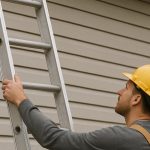Ladder Safety Tips for Homeowners and Roofing Professionals

Ladder Safety Tips for Homeowners and Roofing Professionals By John Petrozzi
When it comes to roof work, ladder safety is paramount. Over the years, I’ve seen far too many accidents that could have been avoided with the right precautions. Today, I’ll share some essential tips on choosing the right ladder, placing it safely, and using it correctly.
Material Matters: Not all ladders are created equal, especially when working near electrical wires. Fiberglass and wooden ladders are safer options because they don’t conduct electricity. In contrast, aluminum ladders can put you at risk of electrocution if they come into contact with power lines. Always choose the right ladder for the job to keep yourself safe.
Optimal Angle: Set your ladder at a safe angle, around 20 to 30 degrees. Too upright and it could tip backward; too shallow and it could slip out from under you. Also, ensure the ladder extends at least three feet above the roof edge for safe transitioning on and off.
Rake vs. Eaves: Whenever possible, place your ladder against the rake edge rather than near the eaves. This can help you avoid damaging gutters and provide a more stable, less obstructed climb—particularly if you’re not a seasoned professional.




However, if you must place the ladder against the gutter, here’s how to do it safely:
Secure the Ladder: Use a wire or rope to tie the ladder rail directly to the gutter spike or bracket. This helps prevent side-to-side movement or tipping.
Using this method can make climbing safer when no rake edge is available. But remember, if you’re unsure—always call a pro.
There’s some debate over whether it’s safer to hold the rungs or the rails (also known as strings) when climbing. Rungs may offer a better grip in case of a slip, but many—including myself—prefer the rails, especially when both hands need to stay in contact for balance.
Ultimately, follow your job site’s rules, and more importantly, use common sense. Whether you’re a rung holder or a rail holder, stay focused and deliberate.
